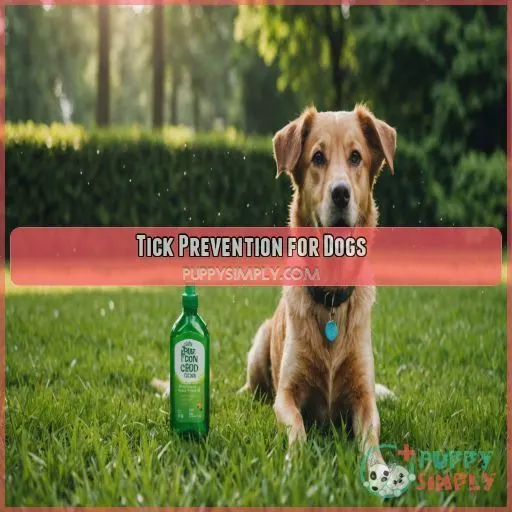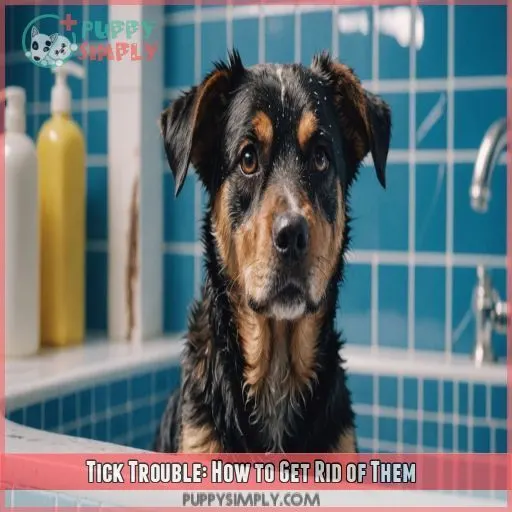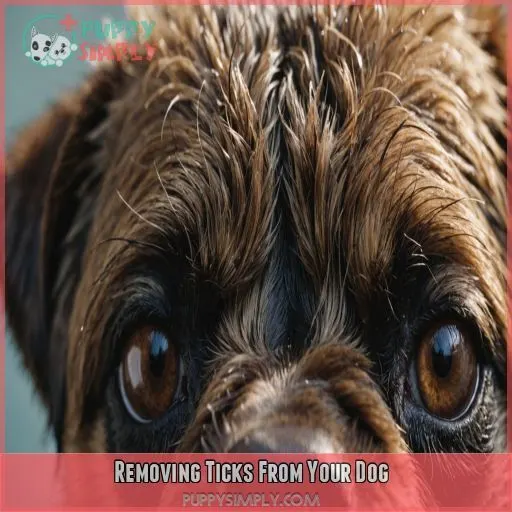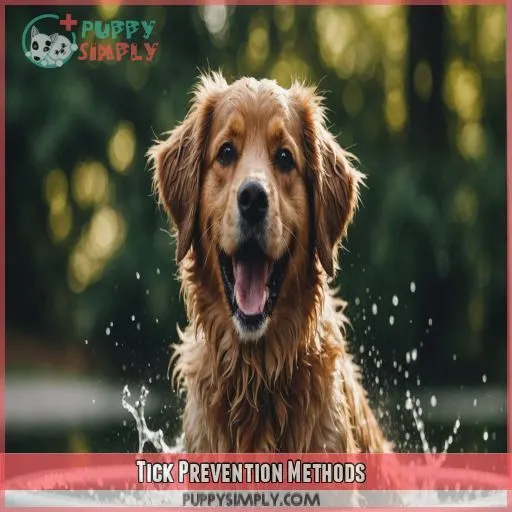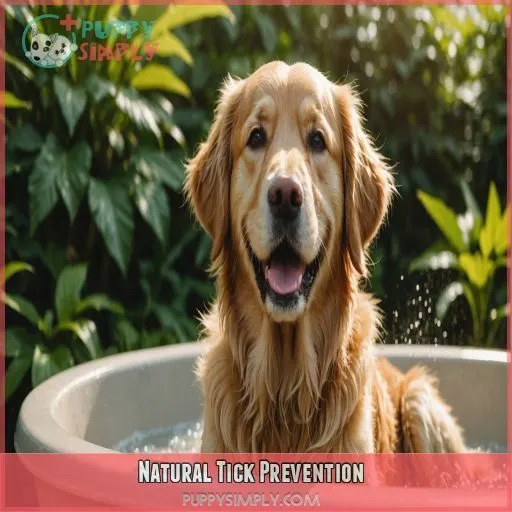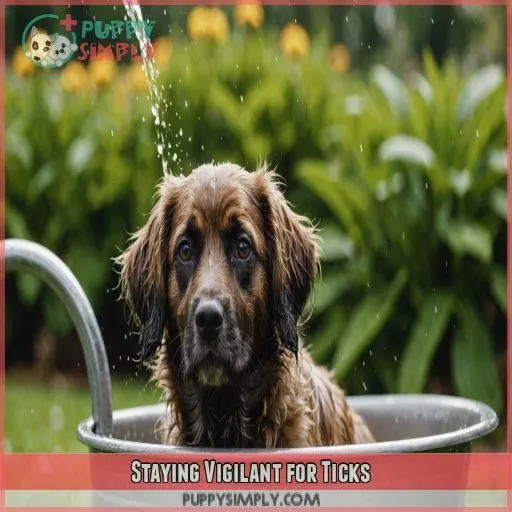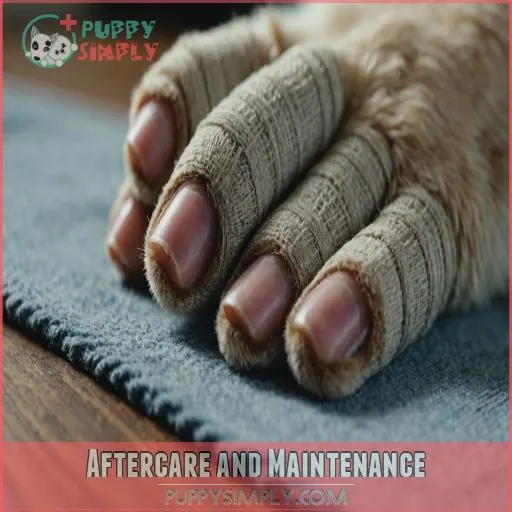This site is supported by our readers. We may earn a commission, at no cost to you, if you purchase through links.
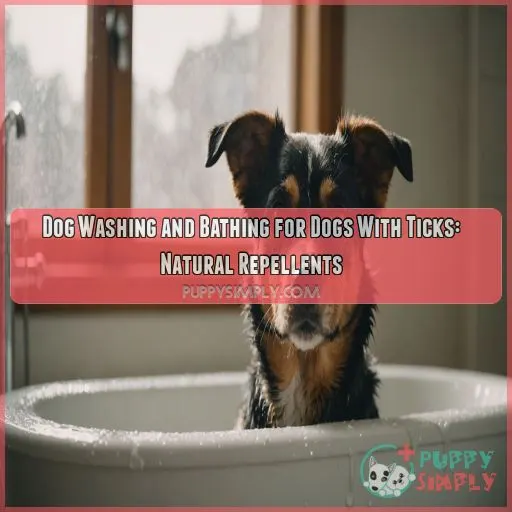
Start by carefully removing any visible ticks using tweezers or a tick removal tool.
Then, lather up your furry friend with a tick-specific shampoo, making sure to work it into their coat thoroughly.
Pay extra attention to tick hotspots like ears, armpits, and between toes.
Rinse well and follow up with a natural repellent like eucalyptus oil for added protection.
Ready to turn your pup’s bath time into a tick-busting adventure? Let’s get into the details of keeping your dog tick-free!
Table Of Contents
- Key Takeaways
- Tick Prevention for Dogs
- Homemade Tick Killer Bath
- Tick Trouble: How to Get Rid of Them
- Removing Ticks From Your Dog
- Keeping Your Home Tick-Free
- Tick Prevention Methods
- Natural Tick Prevention
- Staying Vigilant for Ticks
- Aftercare and Maintenance
- Frequently Asked Questions (FAQs)
- Should I give my dog a bath if he has ticks?
- Do I need to wash everything if my dog has a tick?
- What can I wash my dog with to get ticks off?
- Will dog groomers remove ticks?
- How often should I bathe my dog during tick season?
- Can I use human anti-tick products on my dog?
- Are there breed-specific considerations for bathing tick-infested dogs?
- How long after bathing should I wait to apply tick prevention?
- Can bathing alone effectively eliminate a severe tick infestation?
- Conclusion
Key Takeaways
- Don’t let those tiny ticks tick you off! A combination of medicated shampoos, natural repellents like eucalyptus oil, and regular baths can turn your pup’s spa day into a tick-busting adventure. Just remember, too much of a good thing can strip those natural oils, so keep it to once a month during tick season.
- Ticks are like unwanted house guests – they’ll make themselves at home if you let them! After bathing your furry friend, don’t forget to give your home the royal treatment. Wash bedding, vacuum like there’s no tomorrow, and consider your yard the frontline in your tick-fighting crusade.
- Your vet isn’t just for belly rubs and treats – they’re your secret weapon in the war on ticks! Regular check-ups can catch what your eagle eyes might miss, and they’ll arm you with the latest and greatest in tick prevention. It’s like having a personal tick-busting coach!
- Remember, Rome wasn’t built in a day, and neither is a tick-free pup! Combine bathing with spot-on treatments, oral meds, and a hawk-eye for those sneaky parasites. It’s not just about getting clean – it’s about sending those ticks packing and keeping your furry best friend happy, healthy, and itch-free!
Tick Prevention for Dogs
If you’re a dog owner, you know that ticks are a pesky problem.
These tiny creatures can carry diseases and cause discomfort for your furry friend.
But don’t worry, we’ve got a few ways to help you keep your pup safe and healthy.
From spot-on treatments to oral medications, tick shampoos, collars, and powders, there’s an option to suit every dog and every situation.
Spot-on Treatments for Ticks
Spot-on treatments are a popular choice for tick prevention. Applied topically, they offer a month of protection against ticks and fleas. You can buy them from vets, pet stores, or online.
Oral Medications for Ticks
Oral medications are another effective tool in your tick-fighting arsenal. Administered monthly, these meds:
- Kill ticks and immature fleas.
- Disrupt the flea life cycle.
- Are safe for children and cats.
Tick Shampoos for Dogs
Tick shampoos are an option for keeping ticks at bay. These shampoos contain medicated ingredients that kill ticks on contact. They’re generally inexpensive, but they do require frequent application, typically every two weeks. While not as effective as spot-on or oral medications, they can be a helpful part of your tick prevention arsenal.
Tick Collars for Protection
Tick collars are a great way to protect your dog’s neck and head from ticks. Here’s what you need to know:
- Collar Fit: Make sure the collar is snug but allows for two fingers to fit comfortably underneath. This makes sure it’s not too tight while still allowing direct contact with your dog’s skin, which is important for effectiveness.
- Effectiveness: Tick collars work by repelling ticks, but they must touch your dog’s skin. They’re a convenient option for continuous protection, especially when combined with other tick prevention methods.
- Safety and Side Effects: Keep an eye on your dog for any signs of allergic reactions, such as excessive scratching. Always read the labels carefully and choose a collar suitable for your dog’s size and breed.
Tick Powders for Dogs
Tick powders are an effective way to kill and repel ticks from your furry friend.
But it’s important to use them with caution.
Only use powders that are specifically labeled for dogs, and make sure they’re designed to target both ticks and fleas.
When applying, go slow and avoid your dog’s face and eyes.
During peak tick season, reapply the powder weekly.
Homemade Tick Killer Bath
You’re likely here because your furry friend has ticks, and you want a natural way to get rid of them. Good news: a homemade tick bath is an effective solution.
Gathering Supplies for the Bath
For a homemade tick killer bath, you’ll need a bathtub, warm water, eucalyptus oil, and a towel. You can also use a tick shampoo for added protection.
Preparing the Bath for Your Dog
Now, it’s time to prepare a tick-safe bath for your furry friend. First, fill the tub with warm water, aiming for a depth that reaches your dog’s knees. You want the water temperature to be just right—not too hot, not too cold, but comfy for your pup.
Bathing Your Dog With Eucalyptus Oil
Now, let’s get to the fun part: bathing your furry friend!
Gently wet your dog with the eucalyptus oil and warm water mixture. Be careful to avoid their head and ears. Thoroughly wash and rinse your dog, ensuring you cover all areas.
This DIY tick bath is a safe and natural way to protect your pup.
Maintaining Tick Protection After the Bath
Maintaining tick protection after a homemade tick killer bath is essential to keep your furry friend safe and tick-free. Here are some key steps to follow:
- Regularly check your dog for ticks, especially after outdoor adventures. Ticks love to hide, so be vigilant!
- Consider using a tick prevention medication along with the bath. Two methods are better than one when it comes to these pesky parasites.
- Keep your yard tick-free by removing tick-attracting vegetation. A tidy yard means a safer pup!
- Consult your veterinarian for personalized advice on tick prevention and treatment. They’re the experts, after all.
Tick Trouble: How to Get Rid of Them
Ticks are a menace, but you don’t have to let them take over. It’s time to reclaim your space and give those pesky parasites the boot.
Professional Help for Tick Removal
If you’re facing a serious tick infestation, it’s time to call in the big guns. Professional pest control companies can schedule a tick spray treatment for your home, ridding your space of these pesky parasites.
Alternatively, take your furry friend to a professional groomer for a tick shampoo treatment. They’ve got the expertise to handle it, and you can even bring your dog’s spot-on treatment for application post-shampoo.
Home Sweet Home (Tick-Free)
To make your home tick-free, you’ll want to:
- Blitz bedding: Wash all dog bedding, then spray with a flea and tick spray.
- Declutter: Clear away clutter, especially in tick hiding spots.
- Clean sweep: Mop and sweep floors with bleach to minimise tick hiding places.
- Mattress check: Inspect your mattress and box spring for ticks, and consider using a tick spray.
Yard Checkup for Ticks
Keeping your yard tick-free is really important for preventing infestations. Remove clutter like empty pots and firewood, which ticks love. Ticks prefer moist, shady spots, so be vigilant under trees and shrubs. Stay alert for ticks after rain or landscaping projects.
Protect Your Pup From Ticks
Keeping your furry friend safe from ticks is really important, and there are a few things you can do to help:
- Use a flea and tick spray on your dog and their environment, including furniture.
- Apply a spot-on treatment, like Frontline, for added protection.
- Schedule a follow-up tick spray treatment for your home to make sure those pesky critters are gone for good.
Removing Ticks From Your Dog
Ticks are pesky parasites that can cause serious health issues for your furry friend. Knowing how to remove them safely and effectively is key to keeping your dog healthy and happy.
Identifying Ticks on Your Dog
Knowing what to look for is important when you’re checking your dog for ticks. These pesky parasites can be as small as a pinhead or as big as a pea, depending on their life stage. They usually blend into your dog’s coat with colours like brown, black, or grey, and may lie flat or appear swollen.
Removing Ticks Safely
Getting rid of ticks safely is really important for your dog’s health. If you spot a tick on your dog, act fast. Use fine-tipped tweezers or tick removal tools to grasp the tick as close to your dog’s skin as possible. Pull upward with steady, gentle pressure until the tick releases its grip.
Preventing Tick Re-Infestation
- Regular grooming sessions
- Consistent use of natural repellents
- Maintaining a tick-unfriendly yard
Keeping Your Home Tick-Free
You’ve conquered the ticks on your pup, but your battle isn’t over yet. Keeping your home tick-free is really important to prevent reinfestation and protect your furry friend, so let’s tackle this pesky problem head-on with some natural solutions.
Washing Bedding and Furniture
After removing ticks from your pup, it’s time to tackle their cozy spots. Wash all bedding and vacuum furniture thoroughly. Use hot water and pet-safe detergents to zap those pesky hitchhikers. Don’t forget about your dog’s favorite blanket or toy!
Spraying for Ticks in the Home
You’ve got this! Arm yourself with a pet-safe tick spray and get to work on those tiny invaders. Treat your home like a fortress, focusing on cracks, baseboards, and furniture. Remember, consistency is key in this battle!
Decluttering and Cleaning for Ticks
Ready to banish those pesky ticks? It’s time to roll up your sleeves and declutter! Clear out those hiding spots, from dusty corners to forgotten boxes. A tidy home is your first line of defense in the battle against ticks.
Yard Maintenance for Tick Prevention
After decluttering indoors, turn your attention to your yard. It’s a tick’s playground! Keep your lawn short, remove leaf litter, and create a buffer zone between wooded areas and your lawn. Your pup will thank you!
Tick Prevention Methods
Keeping your furry friend tick-free doesn’t have to be a doggy dilemma. There are several tried-and-true tick prevention methods that’ll have those pesky parasites running for the hills. First up, spot-on treatments are like kryptonite for ticks. Apply these liquid solutions to your pup’s skin once a month, and watch those ticks wave the white flag. Next, oral medications are the secret weapon in your anti-tick arsenal. These tasty chewables work from the inside out, turning your dog into a walking tick repellent. Finally, don’t underestimate the power of good old-fashioned tick collars. They’re like a force field for your dog’s neck and head.
Here are three reasons why tick prevention is important:
- Protects your dog from tick-borne diseases
- Keeps your home tick-free and family safe
- Saves you money on potential vet bills in the long run
Natural Tick Prevention
You don’t have to rely on harsh chemicals to keep your furry friend tick-free. Natural tick prevention methods, like eucalyptus oil baths and homemade shampoos, can be just as effective and gentler on your pup’s skin.
Eucalyptus Oil as a Natural Repellent
Now, let’s talk about a natural tick-fighter that’ll make your pup smell like a spa day: eucalyptus oil. This powerhouse repellent isn’t just for koalas! When used safely, it can be your secret weapon against those pesky ticks. But remember, a little goes a long way with this potent oil.
Natural Shampoos for Tick Prevention
You can whip up a natural tick-repelling shampoo right in your kitchen! Mix gentle castile soap with tick-fighting essential oils like eucalyptus or lavender. It’s like giving your pup a spa day while sending ticks packing. Just remember, natural doesn’t always mean 100% effective, so stay vigilant!
Maintaining a Tick-Free Environment
Keep your yard trim and tidy to make it less appealing to ticks. It’s like giving your outdoor space a buzz cut! Regularly mow the lawn, clear leaf litter, and create a barrier between wooded areas and your lawn. Your pup will thank you for the tick-free playtime!
Staying Vigilant for Ticks
You’ve given your pup a natural tick bath, but the battle isn’t over yet. Staying vigilant is key to keeping those pesky parasites at bay, so let’s explore how to keep a watchful eye on your furry friend and their environment.
Monitoring Your Dog for Ticks
After your natural tick bath, stay vigilant! Regularly check your furry friend for these sneaky hitchhikers. Remember, ticks are like tiny ninjas – they’re experts at hiding.
Here’s your tick-checking checklist:
- Run your fingers through your dog’s fur
- Check between toes and paw pads
- Inspect ears and around the collar
- Don’t forget the tail and underbelly
Regularly Inspecting Your Home and Yard
After checking your pup, don’t forget your home turf! Give your yard and house a once-over regularly. Look for tick hotspots like tall grass, woodpiles, and cozy corners. Remember, a tick-free zone starts with vigilance!
Continuing Prevention Measures
Stay on top of your tick prevention game! It’s not a one-and-done deal. Here’s your ongoing battle plan:
- Stick to your tick prevention schedule like glue
- Turn your yard into a tick’s worst nightmare
- Groom your pup like a pro
Consulting Your Veterinarian for Tick Advice
Your vet‘s your go-to tick guru. They’ll tailor advice to your pup’s needs, keeping Lyme disease at bay. From tick prevention to treatment options, they’ve got the scoop. Don’t be ticked off – let your vet be your ally!
Aftercare and Maintenance
After you’ve tackled a tick infestation, your job isn’t over yet. Proper aftercare and maintenance are key to keeping your furry friend tick-free and healthy in the long run.
Follow-up Care After Tick Removal
After tick removal, don’t let your guard down! Keep a watchful eye on your furry friend for any signs of illness. Give your pup’s favorite spots a thorough cleaning to evict any lingering tick buddies. A quick vet checkup can give you peace of mind and make sure your pooch is tick-free.
Ongoing Prevention Measures
- Stick to a tick prevention schedule like glue
- Turn your yard into a tick’s worst nightmare
- Embrace natural repellents like they’re going out of style
Regular Check-Ups With Your Veterinarian
Regular vet check-ups are your best defense against tick troubles. Don’t skip these important visits! Your vet’s keen eye can catch what you might miss. Here’s a handy reminder of what to expect:
| Check-up Focus | Frequency | Why It Matters |
|---|---|---|
| Tick-borne diseases | Every 6 months | Early detection saves lives |
| Parasite control | Annually | Keeps your pup protected |
| Dental care | Yearly | Prevents tick-friendly gum disease |
Frequently Asked Questions (FAQs)
Should I give my dog a bath if he has ticks?
Yes, you should bathe your dog if he’s ticks. It’s a key step in tick removal and prevention. Use a medicated shampoo or a homemade eucalyptus solution. Don’t forget to check those hard-to-reach spots!
Do I need to wash everything if my dog has a tick?
You might think it’s overkill, but yes, you should wash everything. Ticks are sneaky hitchhikers! Launder your dog’s bedding, vacuum thoroughly, and consider treating your home. It’s better to be safe than sorry when dealing with these pesky parasites.
What can I wash my dog with to get ticks off?
You’ve got options! Try a medicated tick shampoo for an effective wash. Alternatively, whip up a homemade eucalyptus oil bath. Don’t forget to pair these with spot-on treatments or oral meds for maximum protection. Your pup will thank you!
Will dog groomers remove ticks?
You’re in for a surprise! Most groomers will remove ticks, but it’s not always guaranteed. They’re trained to spot and safely extract these pesky hitchhikers. Ask beforehand if they’ll handle tick removal to make sure they’ll tackle your pup’s unwanted passengers.
How often should I bathe my dog during tick season?
During tick season, you shouldn’t bathe your pup more than once a month. Too much washing can strip their natural oils. Instead, focus on regular tick checks and preventive treatments. It’s about balance, not bubbles!
Can I use human anti-tick products on my dog?
Did you know 1 in 3 pet owners mistakenly use human products on their dogs? Don’t join that statistic! You shouldn’t use human anti-tick products on your furry friend. They’re not safe and can be toxic. Stick to vet-approved options instead.
Are there breed-specific considerations for bathing tick-infested dogs?
Yes, there are breed-specific considerations. Long-haired dogs need extra attention to their coats, while short-haired breeds might be easier to bathe. Skin sensitivity varies too, so you’ll want to choose the right shampoo for your pup’s unique needs.
How long after bathing should I wait to apply tick prevention?
Wait at least 24 hours after bathing your furry friend before applying tick prevention. You’ll want to make sure your pup’s coat is completely dry. Think of it like letting paint dry before adding another coat!
Can bathing alone effectively eliminate a severe tick infestation?
Bathing alone won’t cut the mustard for severe tick infestations. You’ll need a multi-pronged approach. Combine bathing with spot-on treatments, oral medications, and environmental control. Don’t put all your eggs in one basket – be thorough!
Conclusion
Dog washing and bathing for dogs with ticks isn’t just about cleanliness; it’s a key part of keeping your pup safe from these pesky parasites.
By combining natural repellents, regular checks, and a vigilant approach, you’re creating a fortress of protection for your furry friend.
Your dog will thank you with wagging tails and tick-free cuddles!

